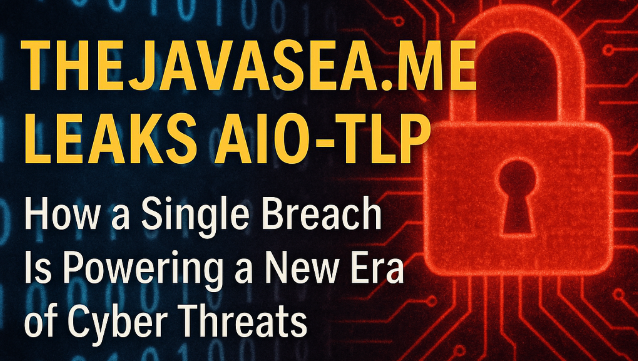In the ever-escalating digital conflict, cyberattacks are no longer limited to elite hackers or advanced criminal syndicates. Increasingly, even entry-level threat actors have access to potent tools capable of large-scale disruption. One of the most disturbing recent developments is the emergence of the thejavasea.me leaks AIO-TLP, a breach that has silently accelerated the pace of cybercrime by releasing plug-and-play attack toolkits across the internet.
While most data leaks typically involve compromised credentials or stolen user databases, this incident is markedly different. It provides comprehensive toolsets—fully operational, pre-packaged, and highly malicious. Its impact stretches across individuals, startups, global enterprises, and even vital infrastructure networks.
What Is the thejavasea.me Leaks AIO-TLP?
The term thejavasea.me leaks AIO-TLP denotes a collection of All-In-One Tactical Level Packages (AIO-TLP) that were leaked via the underground web platform “thejavasea.me.” These kits are specifically designed to make launching cyberattacks easy, repeatable, and devastating—even for individuals with minimal technical know-how.
A typical AIO-TLP bundle might include phishing website builders, credential-stuffing utilities, malware generators, exploit scripts targeting existing software vulnerabilities, remote desktop payloads, and encrypted channels for evading detection systems. These are not partial code samples or theoretical constructs—they are operational, weaponized toolkits primed for immediate deployment.
Why the thejavasea.me Leaks AIO-TLP Are So Alarming
There are several reasons why thejavasea.me leaks AIO-TLP are causing significant concern within cybersecurity circles, but five factors stand out prominently.
Ease of Use
These toolkits are often accompanied by user documentation and simple graphical interfaces, eliminating the need for advanced knowledge. Even users with basic computer familiarity can now launch effective attacks.
Rapid Propagation
Since the initial exposure, replicas of these AIO-TLPs have been widely disseminated across encrypted forums, peer-to-peer networks, and multiple dark net marketplaces. Their rapid distribution puts millions of digital systems in jeopardy.
Rising Attack Volume
Cybersecurity analysts have reported a noticeable spike in automated intrusions targeting online stores, enterprise email systems, and cloud-based platforms—many of which are directly linked to tools derived from the thejavasea.me leak.
Advanced Evasion Techniques
The kits are packed with sophisticated encryption, cloaking, and anti-forensics functionalities that help them dodge traditional antivirus programs and bypass sandbox detection, making containment and analysis significantly harder.
Low Cost, High Impact
With such kits widely accessible, the barrier to entry for malicious actors has all but disappeared. Cybercriminals can now achieve significant disruption and financial gain with minimal effort and investment.
Industries and Users at Greatest Risk
Although the thejavasea.me AIO-TLP leak has the potential to affect virtually anyone connected to the internet, several sectors are particularly susceptible.
Small and mid-sized businesses are frequent targets, often due to their limited cybersecurity budgets and insufficient infrastructure. Healthcare organizations, due to their access to sensitive patient data and operationally critical systems, remain top targets for ransomware operators. Educational sectors, including schools and universities, are vulnerable because of their expansive user bases and often outdated security measures. Meanwhile, remote workers and freelancers operating from personal networks and consumer-grade devices are increasingly exploited.
Even regular internet users are now frequently ensnared in phishing scams and credential-based intrusions stemming directly from this breach.
Examples of Cyber Incidents Linked to the Leak
Cybersecurity experts have already traced several active threat campaigns back to the thejavasea.me leaks AIO-TLP.
Credential Harvesting
Fake login portals built using templates from the leaked kits are being used to steal corporate login credentials on a massive scale. Illicit online gambling platforms, including underground networks like Satta Matka, have also been linked to credential harvesting and dark web activity.
Botnet Expansion
Remote execution scripts from the AIO-TLP packages have been used to infect IoT devices and home routers, turning them into silent nodes in global botnets.
Ransomware Deployment
Several prominent ransomware groups have adopted encryption modules found in the leak to enhance their malware payloads, leading to more sophisticated attacks.
These threats are real and ongoing, costing organizations millions in losses, recovery costs, and reputational damage.
What Actions Can Be Taken to Reduce the Risk?
If your digital systems—whether personal or professional—are exposed to the internet, proactive steps must be taken to defend against tools emerging from the thejavasea.me leak.
For Organizations
Enterprises should deploy real-time threat monitoring through behavioral analytics and endpoint detection systems. Network segmentation must be applied to limit lateral movement. Systems should be regularly patched and updated, and employees trained through simulated phishing tests to improve their response to social engineering attacks.
For Individuals
Users should enable two-factor authentication on all accounts, avoid password reuse by using a password manager, install robust antivirus and anti-malware software with real-time detection, and subscribe to data breach alert services for credential monitoring.
Long-Term Ramifications of the thejavasea.me AIO-TLP Leak
The real threat posed by the thejavasea.me AIO-TLP breach lies not only in the tools themselves but in the trend it signifies. We are witnessing a shift toward AI-powered malware, Cybercrime-as-a-Service (CaaS) ecosystems, and decentralized, self-replicating botnets. These developments are expected to overwhelm already-stretched cybersecurity teams and global law enforcement efforts.
Conclusion
The exposure of the thejavasea.me AIO-TLP toolkit is a defining moment in the evolution of digital threats. Unlike traditional breaches that compromise isolated datasets or entities, this leak equips cybercriminals with an arsenal capable of targeting virtually any system—personal, corporate, or governmental.
The gravity of this threat is undeniable. In today’s hyperconnected environment, cybersecurity is not optional, it is essential. As the line between personal and professional digital spaces continues to blur, it’s more important than ever for all users to stay informed, prepared, and resilient.
